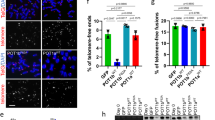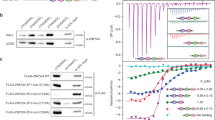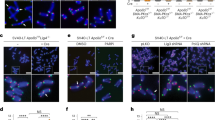Abstract
Human chromosome ends are capped by shelterin, a protein complex that protects the natural ends from being recognized as sites of DNA damage and also regulates the telomere-replicating enzyme, telomerase1,2,3. Shelterin includes the heterodimeric POT1–TPP1 protein, which binds the telomeric single-stranded DNA tail4,5,6,7,8,9. TPP1 has been implicated both in recruiting telomerase to telomeres and in stimulating telomerase processivity (the addition of multiple DNA repeats after a single primer-binding event)9,10,11,12,13,14. Determining the mechanisms of these activities has been difficult, especially because genetic perturbations also tend to affect the essential chromosome end-protection function of TPP1 (refs 15, 16, 17). Here we identify separation-of-function mutants of human TPP1 that retain full telomere-capping function in vitro and in vivo, yet are defective in binding human telomerase. The seven separation-of-function mutations map to a patch of amino acids on the surface of TPP1, the TEL patch, that both recruits telomerase to telomeres and promotes high-processivity DNA synthesis, indicating that these two activities are manifestations of the same molecular interaction. Given that the interaction between telomerase and TPP1 is required for telomerase function in vivo, the TEL patch of TPP1 provides a new target for anticancer drug development.
This is a preview of subscription content, access via your institution
Access options
Subscribe to this journal
Receive 51 print issues and online access
$199.00 per year
only $3.90 per issue
Buy this article
- Purchase on Springer Link
- Instant access to full article PDF
Prices may be subject to local taxes which are calculated during checkout




Similar content being viewed by others
References
Palm, W. & de Lange, T. How shelterin protects mammalian telomeres. Annu. Rev. Genet. 42, 301–334 (2008)
Greider, C. W. & Blackburn, E. H. A telomeric sequence in the RNA of Tetrahymena telomerase required for telomere repeat synthesis. Nature 337, 331–337 (1989)
Lingner, J. et al. Reverse transcriptase motifs in the catalytic subunit of telomerase. Science 276, 561–567 (1997)
Baumann, P. & Cech, T. R. Pot1, the putative telomere end-binding protein in fission yeast and humans. Science 292, 1171–1175 (2001)
Houghtaling, B. R., Cuttonaro, L., Chang, W. & Smith, S. A dynamic molecular link between the telomere length regulator TRF1 and the chromosome end protector TRF2. Curr. Biol. 14, 1621–1631 (2004)
Liu, D. et al. PTOP interacts with POT1 and regulates its localization to telomeres. Nature Cell Biol. 6, 673–680 (2004)
Ye, J. Z. et al. POT1-interacting protein PIP1: a telomere length regulator that recruits POT1 to the TIN2/TRF1 complex. Genes Dev. 18, 1649–1654 (2004)
Lei, M., Podell, E. R. & Cech, T. R. Structure of human POT1 bound to telomeric single-stranded DNA provides a model for chromosome end-protection. Nature Struct. Mol. Biol. 11, 1223–1229 (2004)
Wang, F. et al. The POT1–TPP1 telomere complex is a telomerase processivity factor. Nature 445, 506–510 (2007)
Lue, N. F. Adding to the ends: what makes telomerase processive and how important is it? Bioessays 26, 955–962 (2004)
Latrick, C. M. & Cech, T. R. POT1–TPP1 enhances telomerase processivity by slowing primer dissociation and aiding translocation. EMBO J. 29, 924–933 (2010)
Tejera, A. M. et al. TPP1 is required for TERT recruitment, telomere elongation during nuclear reprogramming, and normal skin development in mice. Dev. Cell 18, 775–789 (2010)
Abreu, E. et al. TIN2-tethered TPP1 recruits human telomerase to telomeres in vivo. Mol. Cell. Biol. 30, 2971–2982 (2010)
Xin, H. et al. TPP1 is a homologue of ciliate TEBP-β and interacts with POT1 to recruit telomerase. Nature 445, 559–562 (2007)
Denchi, E. L. & de Lange, T. Protection of telomeres through independent control of ATM and ATR by TRF2 and POT1. Nature 448, 1068–1071 (2007)
Guo, X. et al. Dysfunctional telomeres activate an ATM-ATR-dependent DNA damage response to suppress tumorigenesis. EMBO J. 26, 4709–4719 (2007)
Hockemeyer, D. et al. Telomere protection by mammalian Pot1 requires interaction with Tpp1. Nature Struct. Mol. Biol. 14, 754–761 (2007)
Cristofari, G. & Lingner, J. Telomere length homeostasis requires that telomerase levels are limiting. EMBO J. 25, 565–574 (2006)
Zaug, A. J., Podell, E. R., Nandakumar, J. & Cech, T. R. Functional interaction between telomere protein TPP1 and telomerase. Genes Dev. 24, 613–622 (2010)
Zhong, F. L. et al. TPP1 OB-fold domain controls telomere maintenance by recruiting telomerase to chromosome ends. Cell 150, 481–494 (2012)
Sexton, A. N., Youmans, D. T. & Collins, K. Specificity requirements for human telomere protein interaction with telomerase holoenzyme. J. Biol. Chem.. http://dx.doi:10.1074/jbc.M112.394767jbc.M112.394767 (2012)
Miyoshi, T., Kanoh, J., Saito, M. & Ishikawa, F. Fission yeast Pot1-Tpp1 protects telomeres and regulates telomere length. Science 320, 1341–1344 (2008)
Moser, B. A., Chang, Y. T., Kosti, J. & Nakamura, T. M. Tel1ATM and Rad3ATR kinases promote Ccq1-Est1 interaction to maintain telomeres in fission yeast. Nature Struct. Mol. Biol. 18, 1408–1413 (2011)
Yamazaki, H., Tarumoto, Y. & Ishikawa, F. Tel1ATM and Rad3ATR phosphorylate the telomere protein Ccq1 to recruit telomerase and elongate telomeres in fission yeast. Genes Dev. 26, 241–246 (2012)
Park, J. I. et al. Telomerase modulates Wnt signalling by association with target gene chromatin. Nature 460, 66–72 (2009)
Majerská, J., Sykorova, E. & Fajkus, J. Non-telomeric activities of telomerase. Mol. Biosyst. 7, 1013–1023 (2011)
Abreu, E., Terns, R. M. & Terns, M. P. Visualization of human telomerase localization by fluorescence microscopy techniques. Methods Mol. Biol. 735, 125–137 (2011)
Weidenfeld, I. et al. Inducible expression of coding and inhibitory RNAs from retargetable genomic loci. Nucleic Acids Res. 37, e50 (2009)
Abell, A. N. et al. Rac2D57N, a dominant inhibitory Rac2 mutant that inhibits p38 kinase signaling and prevents surface ruffling in bone-marrow-derived macrophages. J. Cell Sci. 117, 243–255 (2004)
Berger, S. M. et al. Quantitative analysis of conditional gene inactivation using rationally designed, tetracycline-controlled miRNAs. Nucleic Acids Res. 38, e168 (2010)
Mossessova, E. & Lima, C. D. Ulp1-SUMO crystal structure and genetic analysis reveal conserved interactions and a regulatory element essential for cell growth in yeast. Mol. Cell 5, 865–876 (2000)
Nandakumar, J., Podell, E. R. & Cech, T. R. How telomeric protein POT1 avoids RNA to achieve specificity for single-stranded DNA. Proc. Natl Acad. Sci. USA 107, 651–656 (2010)
Weidenfeld, I. Inducible microRNA-mediated knockdown of the endogenous human lamin A/C gene. Methods Mol. Biol. 815, 289–305 (2012)
Acknowledgements
We thank T. de Lange, M. Terns and S. Langer for suggestions and sharing protocols; T. Nahreini for maintenance of the departmental tissue culture facility; J. Friedman and G. Voeltz for help with confocal microscopy; and A. Berman, S. Borah and M. Nakashima for critical reading of the manuscript. T.R.C. is an investigator of the Howard Hughes Medical Institute (HHMI). J.N. was an HHMI fellow of the Helen Hay Whitney Foundation during a major part of this study and is supported by the National Cancer Institute of the National Institutes of Health under award number K99CA167644. This work was supported in part by US National Institutes of Health grant R01GM29090 to L.A.L. and R01GM099705 to T.R.C.
Author information
Authors and Affiliations
Contributions
J.N. and T.R.C. conceived the project and designed experiments with help from I.W. and L.A.L. on biological aspects. C.F.B. with help from J.N. and A.J.Z. conducted protein purifications, DNA-binding assays and telomerase assays. J.N. and I.W. constructed the stable HeLa cell lines. J.N. performed all remaining experiments including molecular cloning, cell culture, co-IP, TRF analysis and IF–FISH. J.N. and T.R.C. wrote the paper.
Corresponding author
Ethics declarations
Competing interests
The authors declare competing financial interests: T.R.C., J.N., C.F.B. and I.W. have filed a patent application relating to the identification of the TEL patch of TPP1.
Supplementary information
Supplementary Information
This file contains Supplementary Figures 1-13, a Supplementary Discussion and additional references. Supplementary Figures 2-6 show in vitro DNA-binding and direct telomerase assays with TPP1-OB mutants, Supplementary Figure 7 shows an investigation of telomerase components contributing to TPP1-OB binding, and Supplementary Figures 8-13 show the development, validation, and utilization of the HeLa-based system used to address the biological phenotypes (chromosome end protection, telomere maintenance, and telomerase recruitment) of the TEL patch mutants of TPP1. The Supplementary Discussion describes how telomerase recruitment in budding yeast compares to that in humans and S. pombe. (PDF 9289 kb)
Rights and permissions
About this article
Cite this article
Nandakumar, J., Bell, C., Weidenfeld, I. et al. The TEL patch of telomere protein TPP1 mediates telomerase recruitment and processivity. Nature 492, 285–289 (2012). https://doi.org/10.1038/nature11648
Received:
Accepted:
Published:
Issue Date:
DOI: https://doi.org/10.1038/nature11648
This article is cited by
-
Genetics of human telomere biology disorders
Nature Reviews Genetics (2023)
-
Orchestrating nucleic acid–protein interactions at chromosome ends: telomerase mechanisms come into focus
Nature Structural & Molecular Biology (2023)
-
Conformational plasticity and allosteric communication networks explain Shelterin protein TPP1 binding to human telomerase
Communications Chemistry (2023)
-
Targeting telomeres: advances in telomere maintenance mechanism-specific cancer therapies
Nature Reviews Cancer (2022)
-
Structure of active human telomerase with telomere shelterin protein TPP1
Nature (2022)
Comments
By submitting a comment you agree to abide by our Terms and Community Guidelines. If you find something abusive or that does not comply with our terms or guidelines please flag it as inappropriate.



